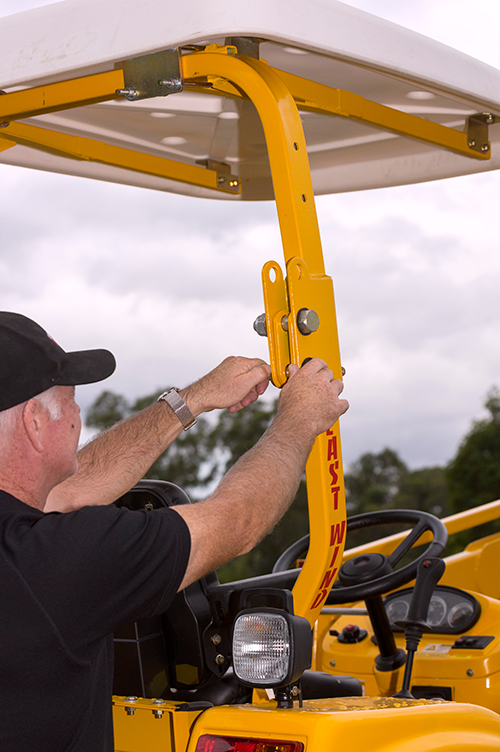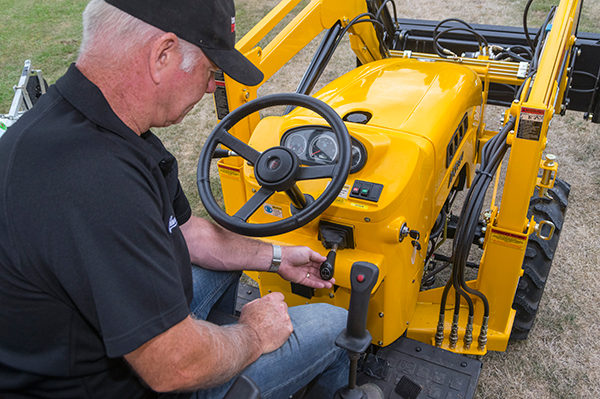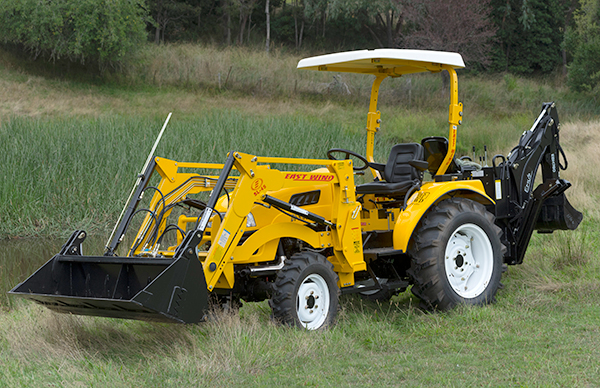Technical Editor Tom Dickson checks out a 45hp East Wind DFS454 tractor to see if this made-in-China-for-Australia machine is up to the tasks it’s designed for
EAST Wind is another of the Chinese-made brands starting to make an impact on the Australian market. Unlike many of the others, though, East Wind is an Aussie-created and controlled brand made to spec in China.
The brand was created by Queensland-based Midway Sales to produce low-cost premium tractors for the Australian market, with the machines being manufactured in the Dongfeng factory in China.
The crew at Midway Sales say they have worked closely with Dongfeng over the last 10 years to produce a tractor that will suit Aussie conditions. They have their own employees in the factory in China to ensure quality control is maintained and to guarantee the tractors are built strictly to East Wind specifications.
The tractors in the range fit into the small-horsepower bracket aimed at hobby farmers, lifestyle farmers, or those who just want to get out on the weekend and clean up around the block without having to fork out a pocket full of money.
Midway Sales makes no attempt to conceal that the biggest selling point of the East Wind range is price. In fact, it uses this as a marketing hook.
The ties between East Wind tractors and the machines Dongfeng sells under its own brand are strong. For instance, our review tractor, the East Wind DFS454, is a 45hp four-wheel drive tractor with 8-speed transmission, synchro shuttle and ROPS, and is virtually identical to the Dongfeng ZB45.
However, the East Wind offers a slightly more deluxe option by including an 8-speed Synchro shuttle transmission, a joystick controller with electronic third function button for the frontend loader, and a step-through deck for easier access and comfort. The improved model will cost around $4000 more than its Dongfeng counterpart.
In addition, Midway Sales says the East Wind tractors are specifically suited to Australian conditions. The company’s confidence is supported by the four-year warranty that it offers.
The most obvious link between the two companies is revealed by the initial DFS (Dongfeng Shuttle), which is emblazoned across the bonnet of the new East Wind.
 |
|
With the ROPS bar lowered, the tractor can get under obstacles and reach areas that are otherwise inaccessible
|
Testing time
I had a brand new East Wind DFS454 with loader delivered to a property at Narre Warren East, on the outskirts of Melbourne, owned by retired engineer John Hughes. The 10-acre property known as Cypress Springs consists of the family home, machinery sheds, paddocks used for grazing and hay production, as well as a bit of bush.
Coincidently, he has a 4WD East Wind DF345 tractor in mint condition parked in his shed. It is one of the first models to go on sale and was purchased about 10 years ago by Hughes to carry out general hobby farming duties like driveway maintenance, drainage work, carting firewood, and cleaning up fallen trees.
Apart from not having a shuttle shift transmission, it looks virtually identical to the new model.
According to Hughes, he has always maintained it well and never asked for more than it is designed for, and that sort of care has resulted in zero breakdowns in 10 years.
I admit to having been sceptical about the performance and reliability of some of the Chinese-made tractors in the past, but listening to Hughes praise the performance of his machine goes a long way towards increasing my confidence. When you factor in the $22,990 purchase price, you would be foolish not to at least have a look.
Engine
The naturally aspirated 45hp 4-cylinder diesel engine in the DFS454 is made by Chinese engine manufacturer Changchai, which specialises in the production of lower-power multi-cylinder and single-cylinder diesel engines ranging from 1.7 to 72kW.
While the brand is not commonly heard of in Australia, Changchai engines are widely used throughout Asia and the company is actually ranked in the Top 500 of industrial companies in China.
The one-piece bonnet can be opened without the need for any fancy tools, which is refreshing, and lifts nice and high to reveal a compact 4-cylinder, direct-injection, liquid-cooled diesel engine. The radiator and air cleaner can easily be accessed for maintenance when the bonnet is up, while the engine oil dipstick can be reached for daily checks without having to lift the lid.
Like most small engines, it performs best at the higher end of its rev range, but despite its open air driving position it still wasn’t overly noisy. In saying that, though, I would always recommend wearing hearing protection during prolonged use.
The exhaust pipe comes out low down at the bottom of the engine near the front wheel, which reduces the noise level considerably but, more importantly, prevents exhaust fumes blowing directly into the face of the operator on the cabinless tractor.
The fuel tank holds a total of 28 litres and has its filling point through the top of the bonnet, just in front of the steering wheel. It’s at a comfortable height to easily fill while you’re standing on the ground beside the tractor.
At around 2000rpm it produces ample power to propel the 2.6-tonne tractor and loader combination up the hills on Hughes’ property and run a 1.5m slasher at the same time.
Having a look under the fibreglass bonnet revealed an area where some obvious cost-cutting techniques have been applied. The standard of workmanship was pretty ordinary and it looked as though the fibreglass had just been thrown at it in the hope of sticking. It’s out of sight and doesn’t affect its performance, but whoever is in charge of quality control deserves a kick up the bum.
The quality of workmanship that went into applying the black trim on the bonnet doesn’t reach the standards that we have come to expect in Australia, either. It looks like it’s been hand painted on by one of the kids at the local kindergarten.
I suppose if you’re going to get it at a price far less than the opposition, you have to expect a few cost-cutting measures.
The engine oil and oil filter must be changed every 100 hours, and it is recommended that the fuel filter element, injector pump oil, front diff and final drive oil, power steering oil, radiator coolant and the air cleaner element be replaced at the same time. The transmission oil and hydraulic oil filter changes are set at 200-hour intervals to coincide with every second engine service.
 |
|
The front console-mounted 4-speed gear lever has a much different feel compared to a four-on-the-floor gear stick
|
Transmission
A dual-range 4-speed gearbox with synchro shuttle shift provides a total of eight forward and eight reverse gears using a dry-type dual-stage clutch.
The 4-speed gear stick is quite firm to operate while changing gears and I suspect this is mainly due to the fact that it is fresh out of the box and only done a couple of hours’ work.
Despite its firmness it is still quite easy to move through the gear range in both directions, and I would expect it to loosen up after a bit of work to provide effortless operation. I would be much more concerned if it was sloppy before the paint had even been burnt off the exhaust.
The gearstick comes out of the centre console just below the steering wheel with a traditional H pattern for selection.
Changing gears has an entirely different feel to that of the traditional style where the stick comes straight up out of the floor between your feet, and I found myself searching for it a bit at times because it was just a bit further away. I reckon an L-shaped extension would solve this by bringing it closer and giving it a four-on-the-floor type feel.
I really enjoyed the luxury of the shuttle shift as it made transitioning between forward and reverse during loader work and slashing an absolute breeze, and sped the job up considerably. Like the gearstick, I also found myself having to reach for it a bit.
The Category 1 rear linkage has a total lift capacity of 665kg at the ball ends. It is supported by a 2-speed PTO (540/1000), which is controlled by a mechanical lever beside the driver’s seat on the left-hand side.
The four-wheel drive engaging lever is also mounted on the left-hand side, while the right side is home to the throttle, linkage control, diff lock, high/low range lever, handbrake, and a couple of lightweight-looking hydraulic levers.
The hydraulic system consists of a main pump delivering a total of 33.6L/min to two sets of hydraulic remotes at the rear. I find it quite puzzling to discover that, instead of having all female ends on the couplers like most tractors do, each set of remotes has one female end and one male end. Most implements that I have seen use male ends, so you would have to change the couplers to match the tractor.
 |
|
The East Wind DFS454 tractor with an Emu EBH 760 three-point linkage backhoe attached. Read our Emu EBH 760 backhoe review here |
Performance
I noticed that it was best to keep the engine revs up a bit. If you let them get too low, it does labour a bit. I was able to eliminate any engine rev droop by setting the engine speed at about 2000rpm and selecting a suitable gear.
The self-levelling front-end loader comes standard with a four-in-one bucket, joystick controller and an integrated third function button. It has a mechanical bucket level indicator to aid its operation. Safety locking pins are included with the loader to lock it in the up position when you’re working in and around the front of the tractor.
The flat-floor design makes it a lot easier to jump on and off, and the open space between your legs and feet provides more comfort for the driver.
The seat is quite comfortable thanks to a basic suspension system which includes height adjustment to help accommodate drivers of varying body size and weight. Moving it backwards and forwards on the slides helps with driver positioning but for me it didn’t come far enough forward, which explains why I felt like I was reaching for the console-mounted gear stick and shuttle lever.
The seat position certainly isn’t a huge issue but if it were my tractor I’d drill a few extra holes and move the whole seat mounting assembly a little bit forward.
The roll-over protection, ROPS, bar is hinged about half-way up, so it may be temporarily lowered. With the bar lowered, the tractor can get under obstacles and reach areas that are otherwise inaccessible.
With a front-end loader for heavy lifting, four-wheel drive to get you through the mud, a roof for weather protection, and lights for night work, there is not much else you could wish for. Add to it a slasher, linkage grader blade, hydraulic log splitter and maybe some lightweight cultivation equipment, and you’ve just about got the job covered.
The bottom line
If you’re in the market for a no-frills tractor that doesn’t include heating, cooling or the latest sound system, the DFS454 could be the one because it seems to tick all the other boxes.
It even has a battery isolation switch to avoid a power drain, which often occurs with hobby and lifestyle farming tractors because they spend a lot of time parked in the shed.
Although the standard of workmanship is below what we call acceptable in Australia, I feel the mechanical performance and general usability of the DFS454 is quite good. The pros certainly outweigh the cons.
If it’s a bit more luxury and comfort from the elements you’re after, maybe check out the cabin version.
At $22,990 it seems to be pretty good value when you consider a half-decent ride-on mower will cost around $20,000, and this gives you so much more.
HITS
- Price
- Synchro Shuttle Shift
- Four-year warranty
- Joystick loader controller
- 4-in-1 bucket
- Step-through deck
- Folding ROPS
- Battery isolation switch
MISSES
- Workmanship on fibreglass bonnet
- Seat positioning
- Hydraulic couplers





